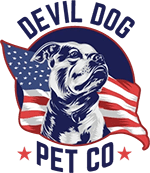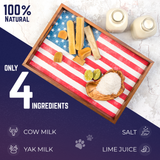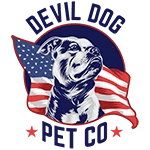Key Takeaways
- Dental disease affects 80% of dogs by age three and is a silent killer.
- Daily dental care can entirely prevent periodontal disease in dogs.
- Untreated dental issues cause bad breath and reduce a dog's lifespan by 2-5 years.
- Bacteria from dental disease can enter the bloodstream and damage vital organs.
- Maintaining your dog's dental health is essential for their overall survival and well-being.
Table of Contents
- Why Dental Health Is Mission-Critical for Dogs
- What Are Finger Brushes and How They Work
- Finger Brush vs. Traditional Toothbrush vs. Dental Chews
- How to Choose the Right Finger Brush for Your Dog
- Step-by-Step: Introducing and Using a Finger Brush
- Advanced Techniques: Maximizing Finger Brush Effectiveness
- Troubleshooting Common Finger Brush Challenges
- Finger Brushes and Beyond: Building a Complete Dental Defense
- The Verdict: When Finger Brushes Excel
Why Dental Health Is Mission-Critical for Dogs
Dental disease is the silent killer lurking in 80% of dogs by age three, and it's entirely preventable with daily leadership. Untreated periodontal disease doesn't just cause bad breath; it shortens your dog's lifespan by 2-5 years as bacteria invade the bloodstream and attack vital organs. This isn't about vanity, it's about keeping your teammate alive and out of the shelter system.
Finger brushes for dogs teeth represent your first line of defense in this daily battle. Unlike traditional brushes that many dogs reject, finger brushes give you tactile control and allow nervous pups to acclimate gradually. Commit to a 90-second routine now, or face thousand-dollar dental surgeries later, the math is brutal but clear.
Smart owners layer their defense: finger brushes for daily front-tooth maintenance and gum health, traditional brushes for deep molar cleaning, and premium chews like yak sticks or bully sticks for passive plaque disruption between brushing sessions.
Leadership Reality Check: Daily brushing + weekly chews = 60% lower risk of dental disease. Miss the early warning signs, red gums, reluctance to chew, or persistent bad breath, and you're looking at emergency extractions that could have been prevented.
What Are Finger Brushes and How They Work
![]()
Finger brushes are silicone or rubber sleeves with flexible bristles that slip over your fingertip, transforming your hand into a precision dental tool. The 360-degree bristle design allows you to clean tooth surfaces and massage gums simultaneously while maintaining complete control over pressure and angle, something impossible with traditional brushes.
Three main types dominate the market: medical-grade silicone with ultra-soft bristles (ideal for puppies and seniors), rubber with firmer plastic nubs (better for heavy plaque), and dual-ended designs featuring both cleaning bristles and gum massagers. Most measure 2.5-3 inches in length and come sized from XS for toy breeds to Large for giants.
The key advantage lies in tactile feedback, you feel exactly what's happening inside your dog's mouth. This direct contact helps identify problem areas early and allows for immediate pressure adjustment if your dog shows discomfort, making finger brushes for dogs teeth the perfect introduction tool for dental care rookies.
Finger Brush vs. Traditional Toothbrush vs. Dental Chews
| Tool | Plaque Removal | Gum Safety | Dog Acceptance | Annual Cost |
|---|---|---|---|---|
| Finger Brush | High (front teeth), Moderate (molars) | Excellent (soft contact) | High (tactile control) | $10-$25 |
| Traditional Brush | High (all surfaces) | Good (with soft bristles) | Moderate (training required) | $15-$30 |
| Premium Chews | Moderate (supplement only) | Varies by hardness | Very High | $100-$300 |
No single tool conquers dental disease alone. Smart owners layer their defense: finger brushes for daily front-tooth maintenance and gum health, traditional brushes for deep molar cleaning, and premium chews like Himalayan Dog Chew for passive plaque disruption between brushing sessions.
The tactical approach combines all three weapons. Start newcomers with finger brushes to build acceptance, graduate to traditional brushes for comprehensive coverage, then supplement with daily chews that work while you're away. This trinity approach delivers maximum protection at reasonable cost.
How to Choose the Right Finger Brush for Your Dog
Size matching is non-negotiable, the brush should cover one canine tooth at a time without overwhelming your dog's mouth. XS fits dogs under 10 pounds, Small handles 10-25 pounds, Medium covers 25-50 pounds, and Large accommodates 50+ pound dogs. When in doubt, size up for safety and longevity.
Medical-grade silicone wins the material battle every time. It's BPA-free, dishwasher-safe, and maintains flexibility through hundreds of uses. Ultra-soft bristles work best for puppies and seniors with sensitive gums, while medium firmness handles adult dogs with healthy mouths. Avoid cheap rubber versions that crack or harbor bacteria.
Multi-dog households need color-coded systems, never share brushes between dogs. Look for non-slip grips and extended tips if you're targeting hard-to-reach molars, but remember that finger brushes for dogs teeth excel at front-tooth cleaning and gum massage rather than deep molar work.
For more advice on dental care routines, see these tips for taking care of your dog's teeth.
Step-by-Step: Introducing and Using a Finger Brush

Preparation beats force every time. Spend two weeks acclimating your dog to mouth handling, daily lip lifts and gentle gum rubs with your bare finger build tolerance before introducing any tools. Rush this phase and you'll create a brush-phobic dog that fights every session.
First session protocol: Apply a pea-sized dab of enzymatic dog toothpaste (never human paste, xylitol kills dogs). Let your pup sniff and lick the paste first, then slip on the finger brush and target front teeth only. Use gentle circular motions and praise calm behavior. Keep the first session under a minute, then gradually increase duration as your dog gains confidence. Always end on a positive note with a favorite chew or play session.
Advanced Techniques: Maximizing Finger Brush Effectiveness
Strategic timing amplifies results. Brush after meals when saliva production peaks, natural enzymes help break down food particles while you mechanically remove plaque. Morning sessions work best for most dogs since they're calmer and more cooperative before daily excitement builds.
Combine tools for comprehensive coverage. Use your finger brush for daily front-tooth maintenance, graduate to a traditional brush twice weekly for molar access, and supplement with Devil Dog's split elk antlers or yak chews for passive cleaning. This rotation prevents tool fatigue while maximizing plaque disruption across all tooth surfaces.
Pro Technique: Track progress with monthly "tooth selfies" using your phone's flashlight. Compare photos to spot problem areas and share visual progress with your veterinarian during annual exams.
For heavy plaque buildup, dip your finger brush in veterinarian-approved chlorhexidine rinse before brushing. This antimicrobial boost disrupts bacterial colonies that standard brushing might miss. Always dilute according to package directions and never substitute human mouthwash, alcohol and xylitol kill dogs.
For a deeper dive into the science behind canine dental care, check out this veterinary research article on oral health.
Troubleshooting Common Finger Brush Challenges
Resistance stems from poor introduction technique, not stubborn personality. If your dog fights the brush, step back to bare-finger gum massage for one week. Let them lick enzymatic toothpaste off your finger until it becomes a positive experience, then reintroduce the brush gradually.
Gum bleeding indicates excessive pressure or underlying dental disease. Switch to ultra-soft bristles and feather-light circular motions. If bleeding persists beyond three sessions, schedule a veterinary exam, inflamed gums require professional assessment before continuing home care.
Dogs who bite down on finger brushes for dogs teeth need immediate tool switching. Never force your finger into a clamping mouth. Traditional long-handled brushes provide necessary distance while maintaining cleaning effectiveness. Some dogs simply aren't finger brush candidates, and that's perfectly acceptable.
Brush deterioration happens faster with aggressive chewers or inadequate cleaning. Inspect weekly for cracks, fraying, or hardened bristles. Replace immediately if any structural damage appears, compromised bristles can scratch gums or harbor bacteria.
Finger Brushes and Beyond: Building a Complete Dental Defense

Finger brushes for dogs teeth work best as part of a comprehensive dental strategy, not a standalone solution. The most effective approach combines daily finger brushing with weekly traditional brush sessions for molar coverage, plus daily digestible chews for passive plaque control.
Cost Reality Check: Premium dental care runs $150–$400 annually versus $500–$1,500 for a single emergency dental surgery. Prevention pays.
Your routine blueprint should include morning finger brush sessions (90 seconds), evening chew time with Devil Dog Pet Co's elk antlers or yak chews for natural scraping action, and annual vet cleanings to catch what home care misses. This three-pronged defense addresses both soft plaque and mechanical tartar removal.
Track progress with monthly "tooth selfies" using your phone's camera. Compare photos every three months to spot early tartar buildup or gum inflammation. Share these images with your vet during wellness exams, visual documentation helps professionals assess your home care effectiveness and adjust professional cleaning schedules accordingly.
To learn more about the pros and cons of antler chews, read are antlers for dogs a good idea.
The Verdict: When Finger Brushes Excel
Finger brushes for dogs teeth deliver exceptional value for nervous dogs, first-time owners, and households managing multiple pets. Their tactile control and gentle approach make them ideal stepping stones to comprehensive dental care, especially when paired with Devil Dog Pet Co's natural chews for complete oral health coverage.
Choose finger brushes if your dog shows anxiety with traditional brushes, if you're building confidence in your brushing technique, or if you need precise control around sensitive areas. They're particularly effective for front teeth and canine cleaning, where their flexible design provides superior access compared to rigid brushes.
Skip finger brushes if your dog has aggressive biting tendencies, if you need deep molar cleaning as the primary goal, or if your dog has advanced periodontal disease requiring intensive intervention. These scenarios demand different tools and professional oversight.
The most successful dental programs treat finger brushes as foundational tools within a broader strategy. Combine them with Devil Dog Pet Co's elk antlers for passive tartar control, rotate in yak chews for mineral supplementation, and maintain regular veterinary cleanings for comprehensive coverage. This multi-tool approach addresses every aspect of canine dental health while building positive associations with oral care routines.
Remember: dental disease remains the leading preventable cause of shelter surrenders. Your commitment to daily finger brushing, supported by quality chews and professional care, keeps your dog healthy, comfortable, and home where they belong.
For a comprehensive comparison of antler types, see deer antler vs elk antler for dogs. For additional scientific insight, review this university guide on brushing for pet dental health.
Frequently Asked Questions
Why is daily dental care so important for preventing periodontal disease in dogs?
Daily dental care disrupts plaque buildup before it hardens into tartar, which leads to gum inflammation and periodontal issues. Consistent brushing helps maintain healthy gums and teeth, reducing the risk of bad breath and serious health complications linked to bacteria entering the bloodstream.
How do finger brushes work and what makes them different from traditional toothbrushes?
Finger brushes slip over your fingertip, giving you tactile control to gently clean teeth and massage gums with flexible bristles all around. Unlike traditional toothbrushes, they allow precise pressure and angle adjustments, making them ideal for dogs uneasy with standard brushes or new to dental care.
What factors should I consider when choosing the right finger brush for my dog?
Look for medical-grade silicone or rubber that’s soft yet durable, fits your finger comfortably, and has flexible bristles to clean all tooth surfaces without causing discomfort. Consider your dog’s size, temperament, and tolerance to handling when selecting the brush size and style.
Can finger brushes be used in combination with other dental care tools like traditional brushes and dental chews?
Absolutely. Finger brushes excel at daily front-tooth and gum maintenance, while traditional brushes reach deeper molars. Pairing these with nutrient-rich chews like yak or bully sticks provides passive plaque disruption, creating a layered defense for your dog’s dental health.






